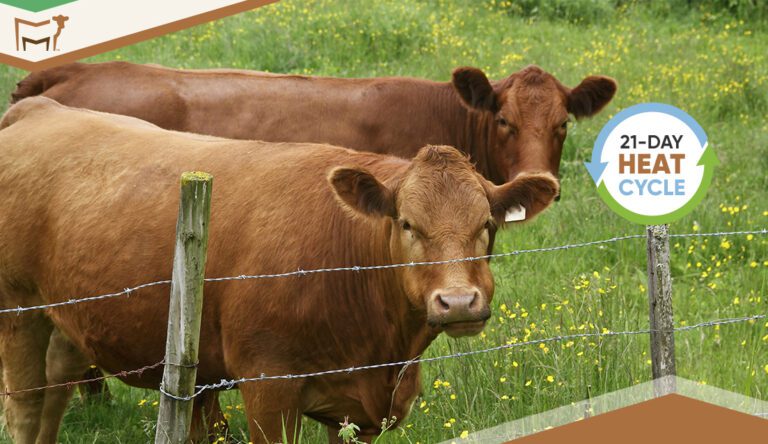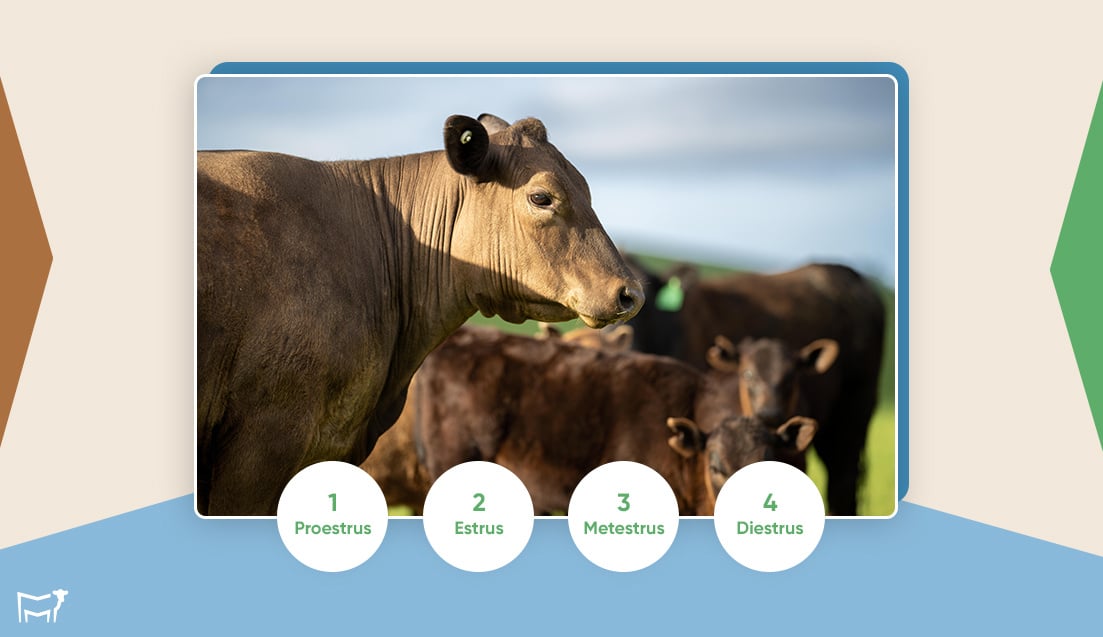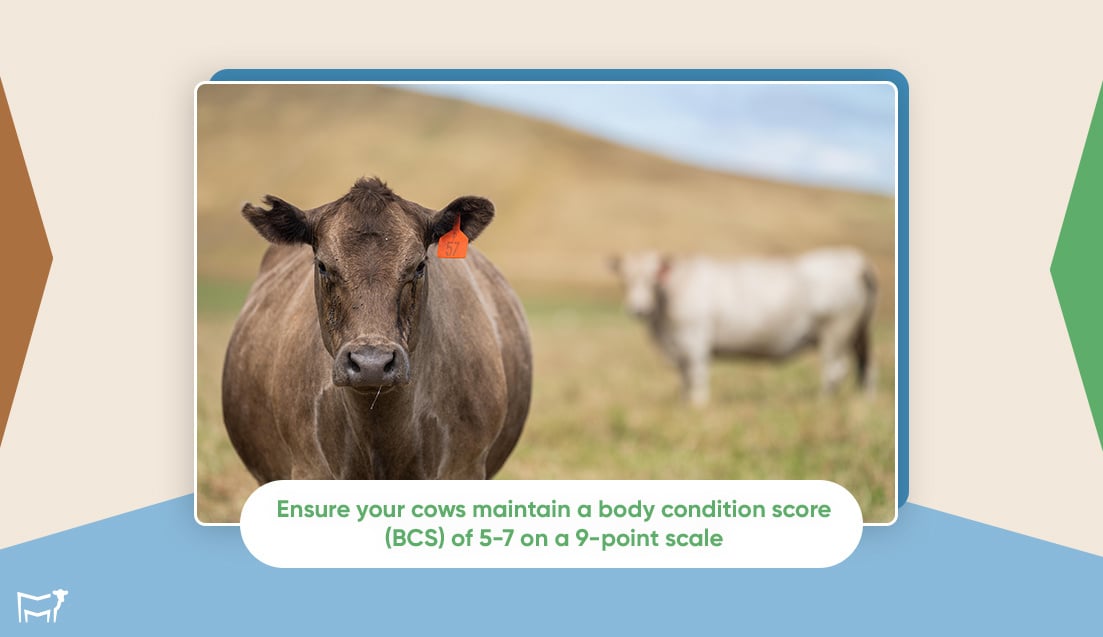Cattle Heat 101: The 21-Day Cycle That Drives Your Ranch's Success

A ranch’s bottom line hinges on one critical number: the percentage of cows that get pregnant during the breeding season. And for that, you need to understand cattle heat cycles. In this post, we’ll cover the basics of cattle heat cycles, their four phases, signs to watch for, and how to keep effective records. Whether you’re new to ranching or looking to fine-tune your operation, this information can help improve your breeding success.
What is a Cattle Heat Cycle?
A cattle heat cycle, also known as the estrous cycle, is the reproductive cycle in female cattle (cows and heifers). This is the period when the cow is receptive to mating, usually lasting 12-18 hours.
The typical duration of a cattle heat cycle is approximately 21 days, although it can vary between 18 to 24 days, depending on the individual animal. This cycle is continuous throughout the year, unlike some other mammals that have seasonal breeding patterns. The cycle begins at puberty, which usually occurs when a calf is around 6-12 months old, depending on factors such as breed, nutrition, and overall health.
Recognizing when a cow is in heat is crucial for planning insemination. Common signs include increased activity, restlessness, mounting other cows, standing to be mounted, clear mucus discharge from the vulva, and swelling of the vulva. Some cows may also bellow more frequently or show a decrease in appetite.
The optimal time for breeding is towards the end of the standing heat period. Ranchers should know that ovulation typically occurs 24-32 hours after the onset of standing heat. Using the “AM/PM rule” can be helpful — if a cow is observed in standing heat in the morning, she should be inseminated that evening; if observed in the evening, she should be inseminated the next morning.
New ranchers often make the mistake of not paying attention after breeding or insemination. But watch for signs of a return to heat, which could indicate failed conception. Most cows should not show heat again for at least 18 days if pregnant. However, some cows may have a short cycle and return to heat in about 14 days.
Keep detailed records of breeding dates to anticipate when cows might return to heat if not pregnant. Observing post-breeding behavior can help you identify potential early embryonic loss or cows that may need to be rebred. It’s also a good practice to watch for signs of abortion or discharge in the weeks following breeding. Early identification of open cows allows for timely rebreeding or management decisions. Use early pregnancy detection methods, like blood tests or ultrasound, to confirm conception and identify open cows as soon as possible.
4 Phases of Cattle Heat Cycle

There are 4 phases of the cattle heat cycle — Proestrus, Estrus, Metestrus, and Diestrus.
Understanding these distinct phases helps you time your breeding precisely and manage your herd’s reproduction effectively. It’s about recognizing the specific signs and knowing exactly when each cow is ready for breeding.
Proestrus (commonly called the “coming into heat” phase) lasts 2-3 days. During this time, the cow’s body prepares for ovulation. You’ll notice increased blood flow to her reproductive tract. Her vulva may appear slightly swollen and pink. She might seem more alert and restless but won’t yet allow mounting by bulls or other cows.
Estrus (called “heat” or “standing heat”), typically spans 12-18 hours. This is when the cow is fertile and receptive to breeding. She’ll stand still when mounted by other cattle. You’ll likely observe clear, stringy mucus discharge from her vulva. Her activity level increases noticeably – she may walk more, bellow frequently, and attempt to mount other cows. This is the crucial time for breeding or insemination.
Metestrus follows, lasting about 3-4 days. The cow is no longer receptive to breeding. Ovulation occurs early in this phase, usually within the first day. You might see some bloody discharge as her reproductive tract returns to its non-estrus state. Her behavior returns to normal during this time.
Diestrus (“resting phase” or “between heats”) is the longest phase, continuing for 12-14 days. The cow’s body maintains a state of potential pregnancy. Progesterone levels remain high. You won’t observe any breeding behavior during this time. If she’s not pregnant, her body will begin preparing for the next cycle towards the end of this phase.
Role of Nutrition and Environment During Cattle Heat Cycle

Proper nutrition plays a crucial role in maintaining regular heat cycles and supporting successful pregnancies. Ensure your cows maintain a body condition score (BCS) of 5-7 on a 9-point scale. Cows that are too thin or too fat may have irregular cycles or fail to conceive.
Provide a balanced diet with adequate energy, protein, vitamins, and minerals. Pay special attention to trace minerals like copper, zinc, and selenium, which are essential for reproductive health. Adjust feed rations based on the stage of production – requirements will differ for dry cows, lactating cows, and growing heifers. Supplement with high-quality forages or concentrates if pasture quality is poor. Nutritional stress can delay puberty in heifers and extend the postpartum interval in cows, directly impacting your breeding program’s efficiency.
Heat stress, in particular, can suppress signs of estrus, reduce conception rates, and increase early embryonic death. During hot weather, provide adequate shade and cool, clean water. Adjust breeding schedules to cooler parts of the day or year in extreme climates.
Minimize handling and transportation stress during the breeding season and early pregnancy. Maintain comfortable, clean environments to reduce the risk of reproductive tract infections. For winter breeding, ensure cows have wind protection and dry bedding. Manage mud in high-traffic areas to prevent foot problems that could interfere with mounting behavior. By proactively managing environmental stressors, you can help ensure your cows display clear heat signs and maintain optimal fertility.
Keeping Records of Cattle Heat Cycles
Tracking heat cycles gives you a clear picture of each cow’s reproductive health. It helps you predict when a cow will come into heat next, which is essential for timing breeding or artificial insemination. By knowing when cows will be in heat, you can schedule labor, arrange for artificial insemination technicians, or plan bull placement more efficiently. Proper records also help identify cows with irregular cycles or those that aren’t cycling at all, allowing you to address potential health issues early.
All these factors contribute to a more productive herd, which leads to better profitability for your operation.
Traditional methods
Ranchers have long relied on paper-based systems and spreadsheets to keep track of their cattle’s heat cycles. They jot down observations in small notebooks while out in the field, noting things like cow ID numbers, dates of observed heat, and any unusual behaviors. These field notes are then transferred to more permanent records back at the ranch office. Wall calendars are a common sight in many ranch offices. Ranchers mark important dates like observed heats, breeding attempts, and expected return to heat for each cow.
For those using digital methods, spreadsheets are a popular choice. Ranchers set up sheets with columns for cow IDs, important dates, and notes. These spreadsheets allow for some basic sorting and filtering of information.
While these methods have served ranchers well for many years, they do come with limitations.
- Data can be scattered across different records, making it hard to get a complete picture.
- There’s also the risk of physical damage or loss of paper records.
- Spreadsheets, while more durable, can become unwieldy as the amount of data grows, and they lack advanced analysis capabilities.
- You have to be really careful about writing everything down, every single time. It’s easy to forget or make mistakes.
As your ranch grows, these issues can start to affect how well you can manage your breeding program. It might mean missed breeding opportunities or overlooked health issues, which can hit your bottom line.
The most efficient way to keep records
One alternative to these traditional methods is — Cattlemax, a digital cattle management system designed specifically for ranchers. Doesn’t involve paper cuts, squinting at your own handwriting, or endless rows in a spreadsheet.
It addresses many of the limitations of paper records and basic spreadsheets:
- All-in-one system: CattleMax keeps all your breeding, pregnancy, and general cattle records in one place. You don’t have to flip between different notebooks or spreadsheets to get a complete picture of a cow’s history.
- Safe and accessible: Being digital, you don’t have to worry about losing records to damage or misplacement. You can access your data from anywhere, making it easy for multiple people to use and update records.
- Scalable: As your herd grows, CattleMax grows with you. It’s designed to handle large amounts of data without becoming unwieldy or slow.
- Automated calculations: The system automatically calculates important dates like estimated calving dates. This reduces the reliance on memory and manual calculations, potentially reducing errors.
- Easy data entry: CattleMax offers features like group updates for pregnancy checks, making it quicker and easier to keep records up-to-date.
- Pattern recognition: With all your data in one system, it’s easier to spot trends or issues in your herd’s reproductive performance.
- Team-friendly: Multiple people can access and update records, improving communication and consistency across your operation.
What sets CattleMax apart is our commitment to the ranching community. Every CattleMax customer service representative is a real rancher who uses the system daily on their own operation. This means when you call for support, you’re talking to someone who truly understands your needs and challenges.
You can try CattleMax for free for 21 days. This gives you the chance to explore all the features and see how they can streamline your breeding management without any financial commitment. To help you get started, we even offer a personal demo. This one-on-one session allows you to ask questions, see the system in action, and learn how to tailor CattleMax to your specific needs. You can book the demo here.
Don’t let outdated record-keeping methods hold back your ranch’s potential. Give CattleMax a try and experience the benefits of modern, efficient cattle management.

Jacqueline
Jacqueline, a true Wyoming native, was raised on her family's ranch just north of Cheyenne. Her journey led her to the University of Wyoming, where she earned a Bachelor of Business Administration in Management and Marketing. She and her husband, Darrell, manage a thriving herd of commercial Angus cattle.







